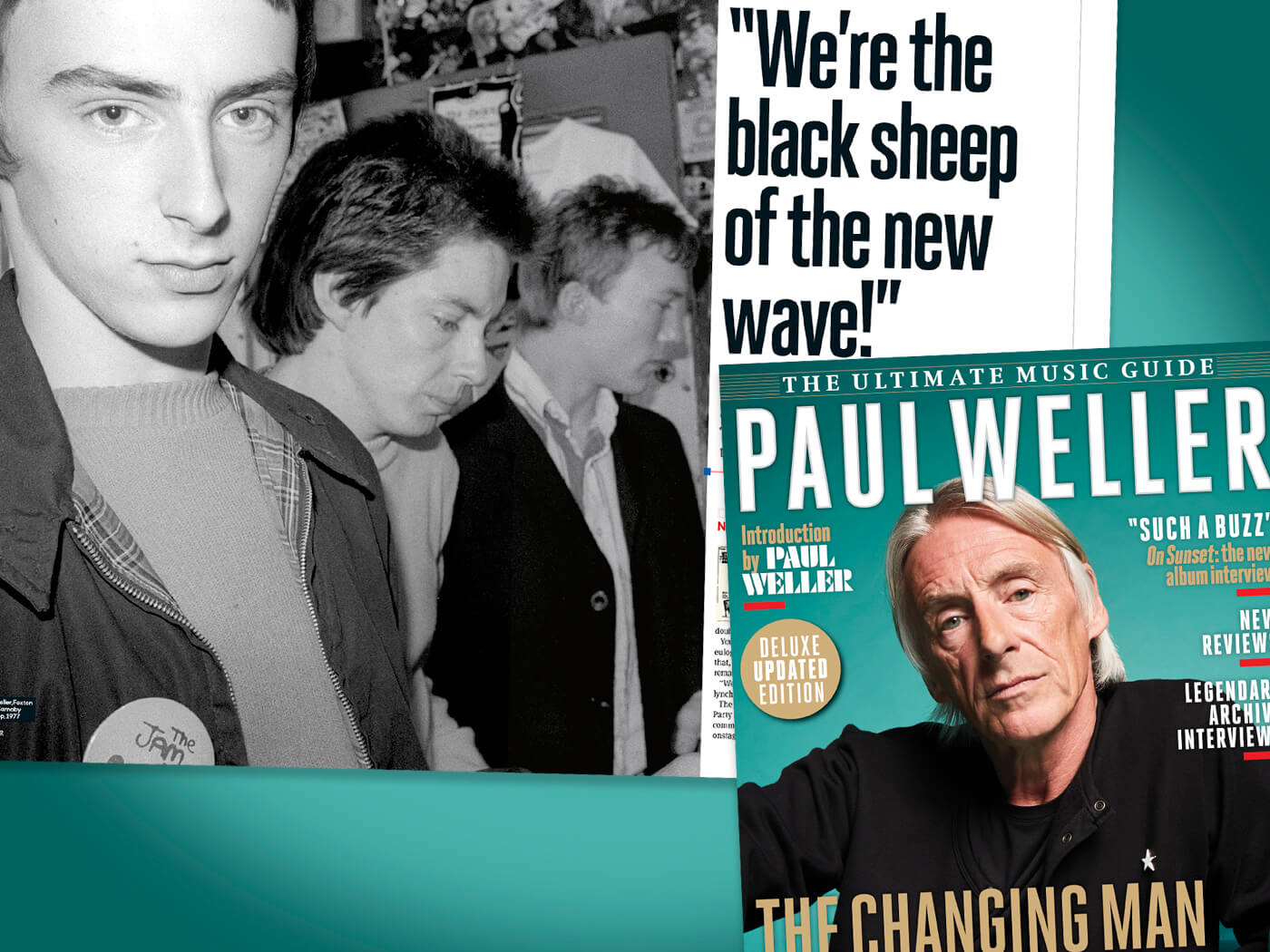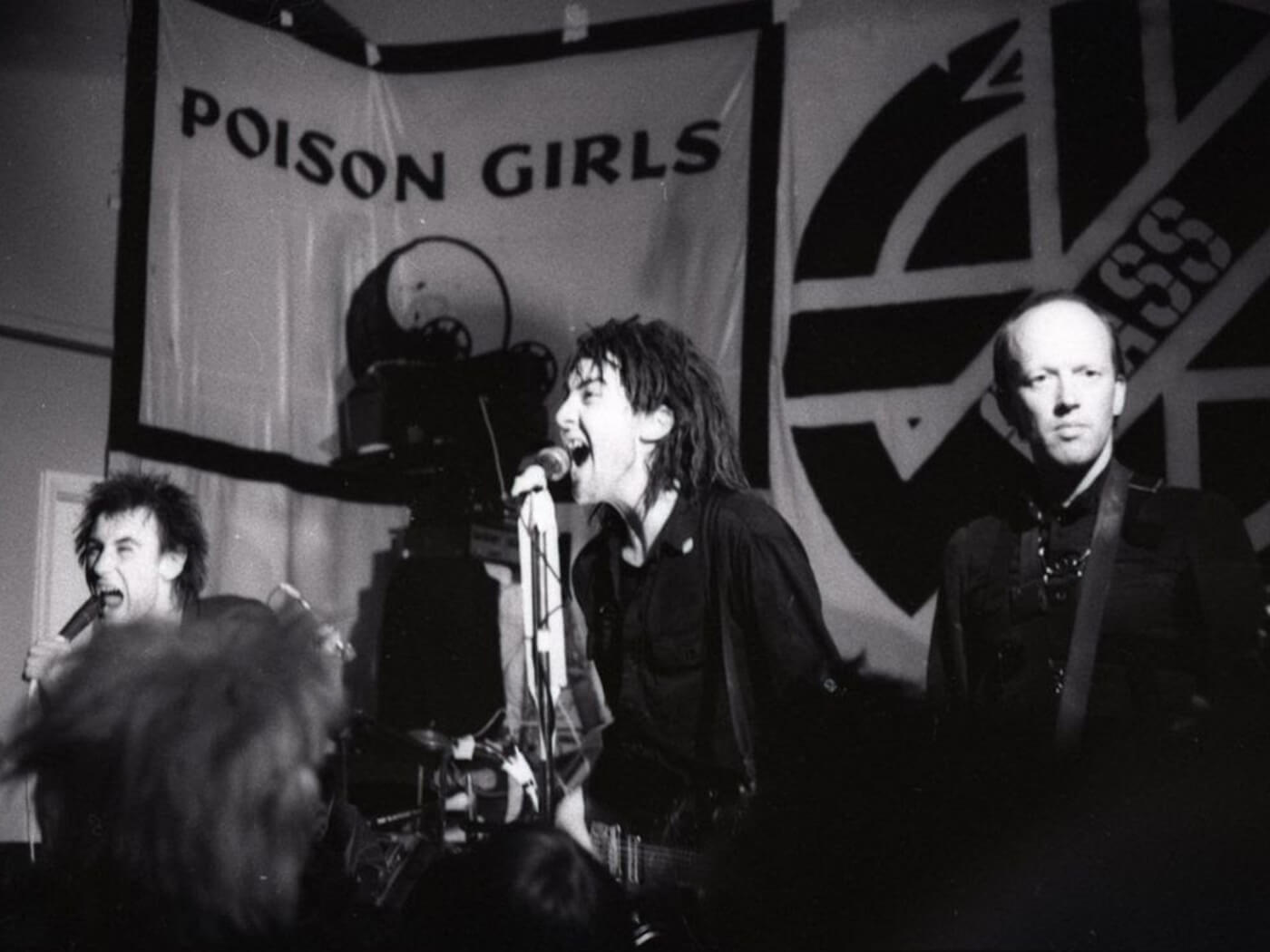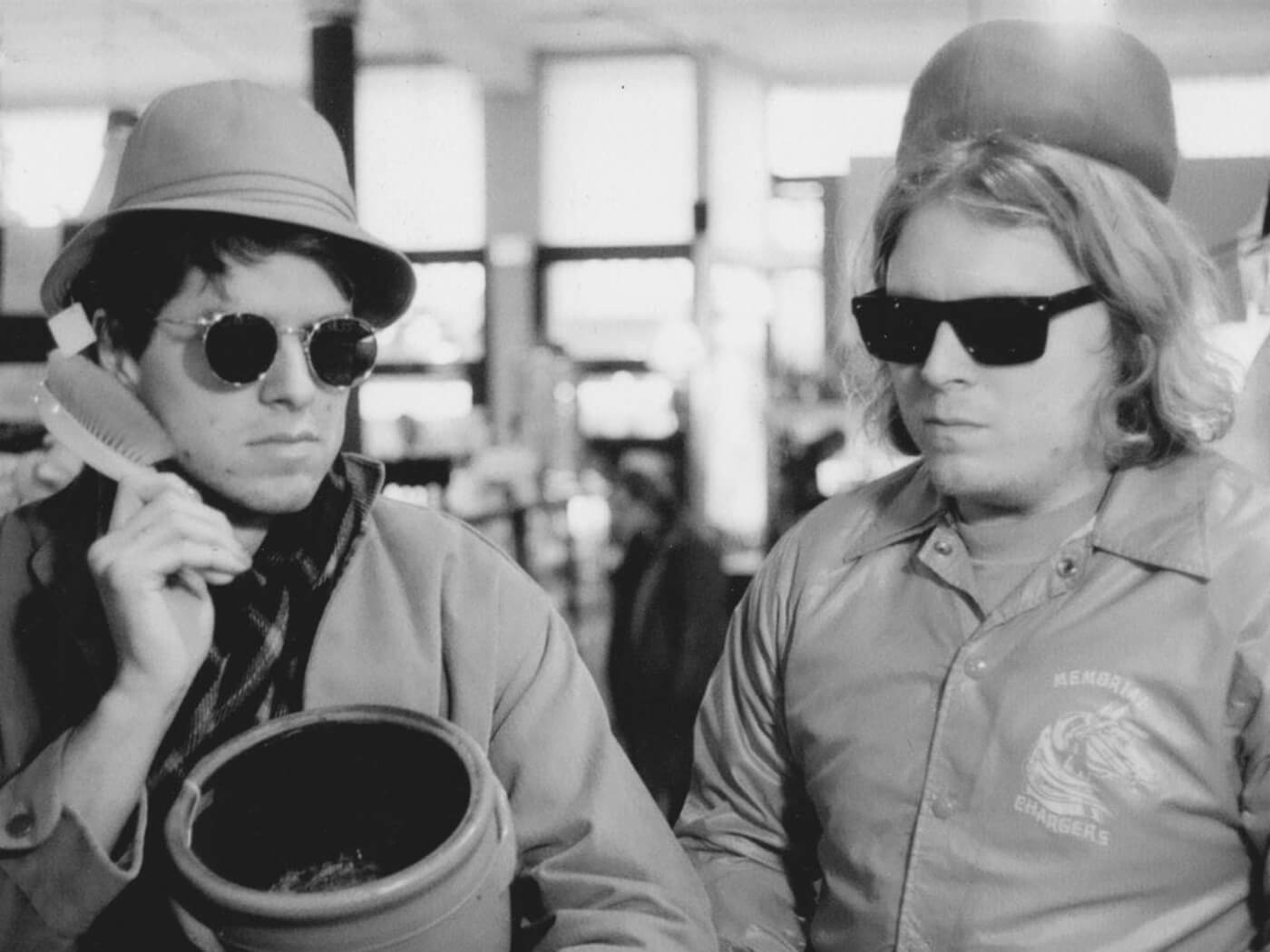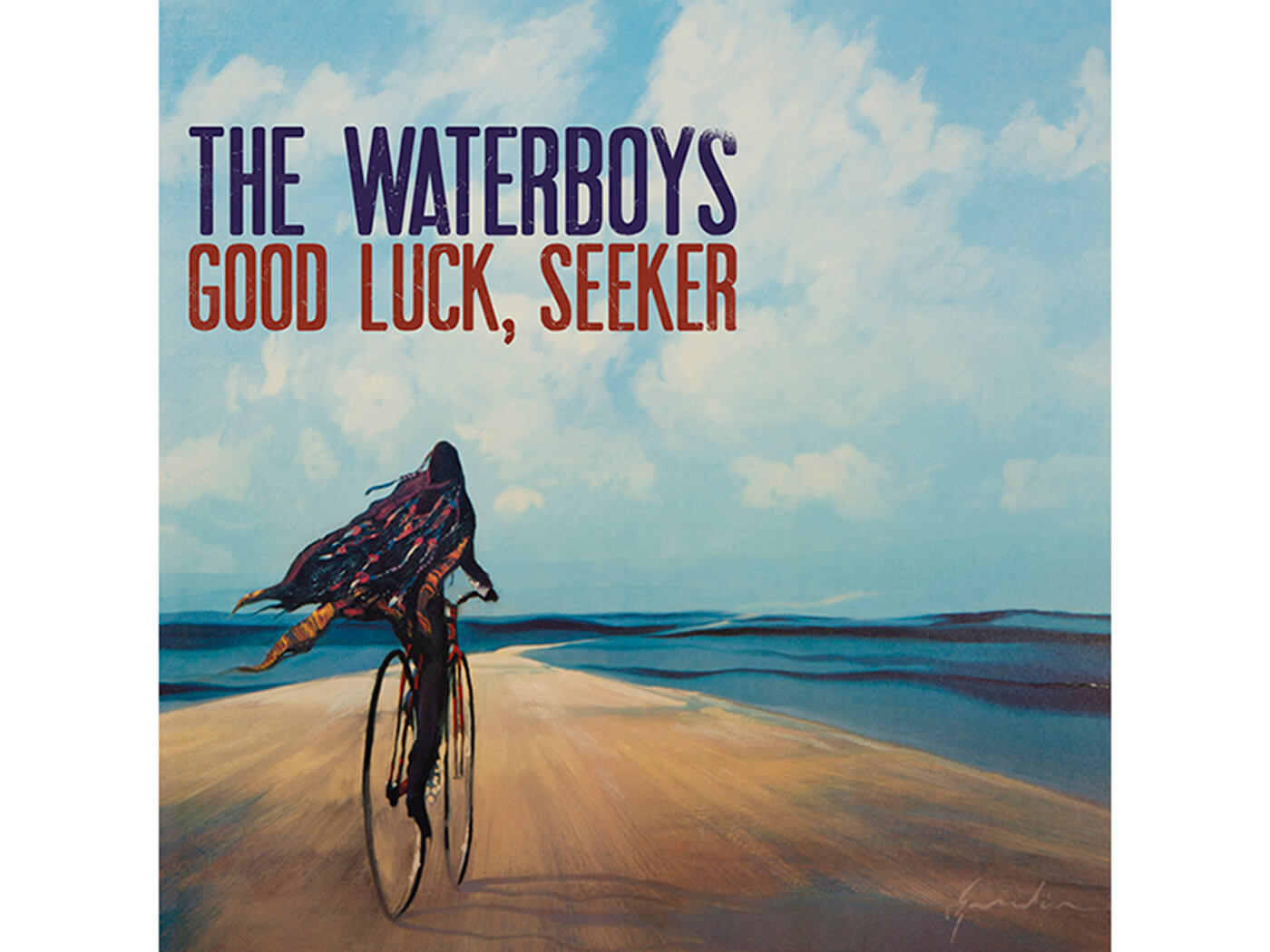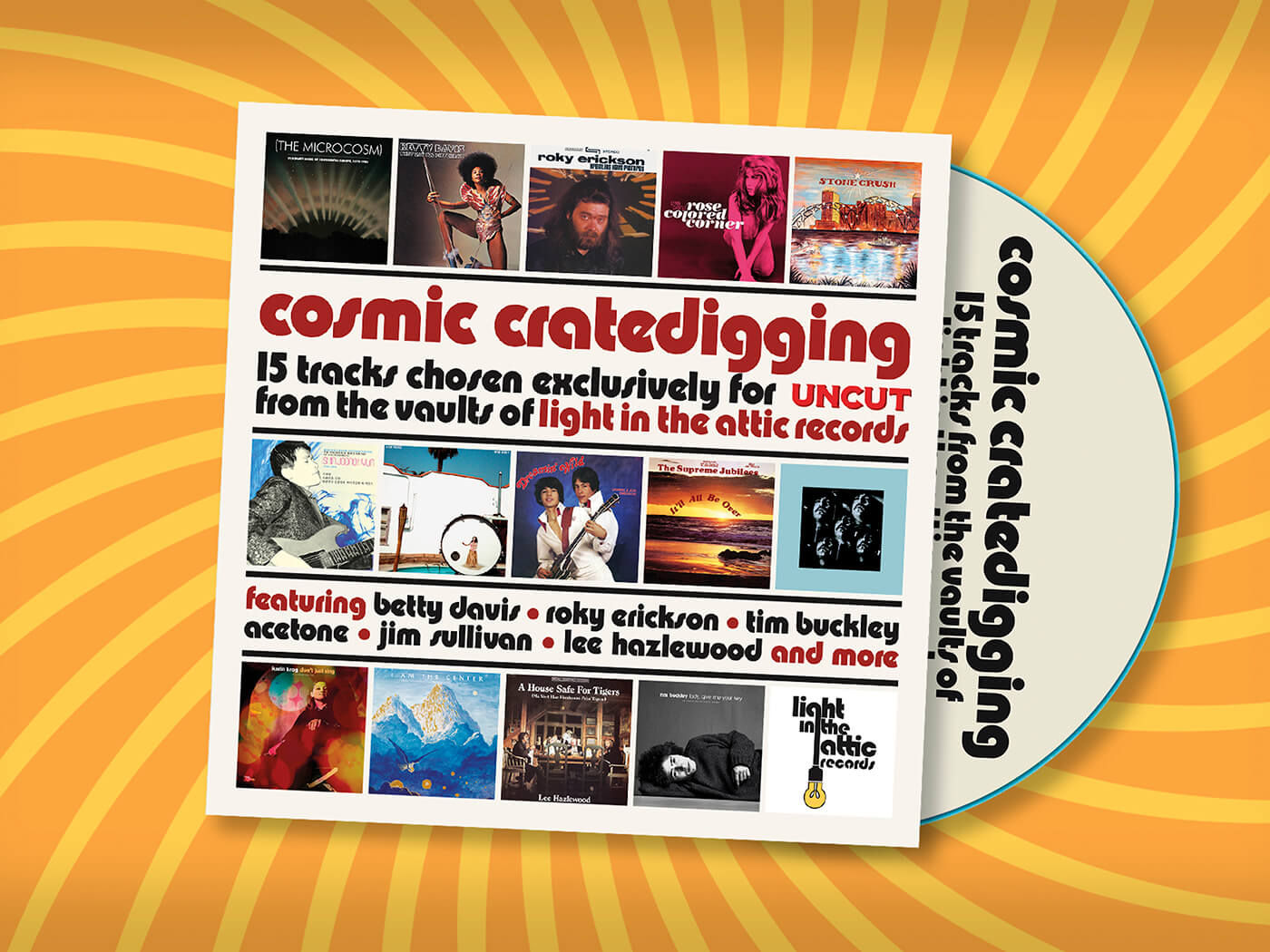Introducing the fully-updated, deluxe edition of our Ultimate Music Guide to the music of Paul Weller. Featuring a wealth of spiky archive interviews and in-depth reviews of every album, from The Jam to The Style Council, all the way to this month’s On Sunset. “It’s philosophical,” Paul tells us in an exclusive new interview, “but also tongue in cheek.”
Paul Weller – The Deluxe Ultimate Music Guide
Introducing the Deluxe Ultimate Music Guide to Paul Weller
Even with a new album out this week, and with the pandemic striking at the heart of how musicians operate, there’s no stopping Paul Weller. As he tells us in a new interview for this fully-updated deluxe Ultimate Music Guide, he’s been busy completing rough ideas, writing at home, and collaborating remotely with his band. “I’ve already got enough for a new record,” he says.
We shouldn’t be surprised. If there’s a constant feature of Weller’s story, it’s that he’s a musician whose career has been characterised by tremendous industry. From the fire of The Jam, the experimentation of The Style Council to the flowering of his solo career, Weller’s musical changes have been based on a bedrock of social responsibility and growing wisdom.
Even in our changed times he sees something to work with. “The air is noticeably cleaner,” he says. “I’ve started seeing and hearing birds again, the birdsong can be so loud. I’ve found it encouraging to think that the planet only needs a few weeks to start to repair itself. The planet will be here long after we’ve gone. Hopefully people can see that we are part of something bigger and we are lucky to be here.”
Perhaps we’ll hear the fruit of Paul’s insights on subsequent records. For the moment, though, we can reflect on his story so far in the Ultimate Music Guide’s blend of spiky archive interviews and deep critical evaluation of the work. It’s a journey which has taken us from the fire and skill of In The City to the innovative and soulful explorations of his latest album On Sunset. And much as we feel fortunate to be on the trip with him, it’s worth noting that Paul feels pretty grateful to be on it himself.
“My escape was music because nothing else made any sense,” he tells us. “I don’t know what I’d have done if I didn’t have music.”
The Deluxe Ultimate Music Guide to Paul Weller is in shops tomorrow (June 11). Alternatively you can order it online by clicking here.
Enjoy!
John Robinson
Nubya Garcia and Shabaka Hutchings feature on new Blue Note comp
Due for release on September 25, Blue Note Re:imagined is a new compilation featuring classic tracks from the history of the label reworked by up-and-coming British jazz and soul talent.
It features Shabaka Hutchings, Ezra Collective, Nubya Garcia, Mr Jukes, Steam Down, Emma-Jean Thackray, Ishmael Ensemble, Melt Yourself Down and more covering tracks by the likes of Wayne Shorter, Herbie Hancock, Bobby Hutcherson, Joe Henderson, Donald Byrd and McCoy Tyner.
Listen to Jorja Smith’s version of St Germain’s “Rose Rouge”, which originally sampled Marlena Shaw’s Cookin With Blue Note At Montreux:
Hear Crass’s “They’ve Got A Bomb” remixed by XL’s Richard Russell
Last year, anarcho-punk firebrands Crass made the original stems for their 1978 debut album The Feeding Of The 5000 available as a free download, and invited all-comers to remix one of the tracks.
Now two efforts by ‘name’ remixers Richard Russell (Everything Is Recorded/XL label boss) and experimental synth-pop artist Glasser are being released on 12″, with all proceeds going to the domestic abuse charity, Refuge.
Pre-order the limited edition red vinyl 12″ – due out on July 24 – here, and listen to Richard Russell’s remix of “They’ve Got A Bomb” below:
Create your own remix by downloading the stems to The Feeding Of The 5000 here.
Hear the new single by Ty Segall and Wand’s Cory Hanson
Ty Segall and Wand’s Cory Hanson have released a collaborative single featuring the tracks “She’s A Beam” and “Milk Bird Flyer”.
Both songs were recorded five years ago, and were recently rediscovered. Listen to “She’s A Beam” below:
You can download the single exclusively from Bandcamp, with 100% of the first week’s sales of both songs donated to Black Lives Matter LA.
The Dream Syndicate – The Universe Inside
The Dream Syndicate’s third album since reuniting earlier in the decade opens with what may be the boldest, weirdest, longest track in their long career. Assembled from pieces of an 80-minute late-night jam during sessions for 2019’s These Times, the song constructs a rambling groove from Dennis Duck’s kosmische drumbeat, Mark Walton’s fatback bass, Chris Cacavas’s swirls of keyboard, and scribbles of guitar from Steve Wynn and Jason Victor. Later, they added electric sitar, skronking saxophone and low vocals that split the difference between Ken Nordine and Tom Waits. The song rolls on and on, picking up instruments and ideas before discarding them, then it rolls on some more, gradually building to a brief, explosive climax.
Clocking in at 20 minutes, it’s by far the band’s longest recorded composition to date, and it serves as a blueprint for this kaleidoscopic record. Featuring members of fellow Paisley Underground champions The Long Ryders, Richmond’s beloved House Of Freaks, and the Marcus Tenney Trio, The Universe Inside turns The Dream Syndicate’s psych-pop inside out, largely dispensing with Wynn’s melodic hooks in favor of a grittier, more hallucinogenic sound that’s ideal for staring at your hand for an hour. It’s a complete departure from their previous two records, 2017’s fine comeback, How Did I Find Myself Here? And follow-up These Times, and far more adventurous than you might expect from a reunited band 30 years from their heyday.
The Universe Inside is a new kind of LP for them, but this type of elongated jam is not. After establishing themselves as the link between dark post-punk distortion and brighter Paisley Underground hooks – which made them a direct influence on bands like REM and The Bangles, among other acts – The Dream Syndicate took to experimenting with noise. Mostly it was onstage, where a song might mushroom past its lyrical structure in new and unexpected directions. That tendency toward improvisation, however, bled into their 1984 studio album, Medicine Show, particularly the 10-minute “John Coltrane Stereo Blues”, which sounded like they were suddenly backing Albert Ayler. Wild and boisterous and messy, the song quickly became a live staple.
But they’ve never given over a full album to this kind of open-ended, exploratory groove, and it makes for a compelling new chapter in their long history. After that epic opener, The Universe Inside closes with an 11-minute Beat poem called “The Slowest Rendition”, during which the band provides an ominous soundtrack as Wynn narrates his worried inner monologue. Marcus Tenney, a Richmond jazz musician, switches between saxophone and trumpet, both of which lend the song an industrial-noir atmosphere. The song falls apart and they put it back together again, each time making it a little more hypnotic and unsettling, as Wynn instructs them, “Keep moving the pieces, keep shuffling the deck.”
The songs in between those two lengthy bookends contract and distend fluidly, as though you’re listening to a lava lamp. “Apropos Of Nothing” shifts tempo repeatedly, but maintains its menacing momentum thanks to the solid rhythm section and prismatic horns, and “Dusting Off The Rust” sounds like a Rube Goldberg contraption, each instrument tripping the next. In all the commotion, Wynn’s voice is often reduced to another element delivering pure sound and rhythm, to the extent that his words can sound purposefully unintelligible.
Even in this setting, however, he remains a resolute songwriter, his lyrics evoking the push and pull between order and chaos, between structure and sprawl, between melody and noise, between playing the music and letting it sweep you along. “You felt invincible, anything was possible,” he sings on “The Longing”, which crystallises the album’s ideas about alienation and disconnection. “Now all that’s left is the longing.” Wynn might be talking about his band’s first run back in the 1980s, or some recent eureka of inspiration, or just a moment of connection with another human being. But the song shimmers and wavers queasily, like they’re not sure if this is a bad trip or not.
That friction illuminates these songs even when they don’t seem to be going anywhere at all, or when they take too long to get there. Yet it’s still bracing to hear a reunited band so fearlessly recalibrate who they are together, what they do, and how they do it. They’re looking to each other to see where this all takes them – not just the reunion, but the music they’re playing together at any given moment. Rather than trying to recapture old sounds and past glories, The Dream Syndicate sound like they’re trying to figure out what lies beyond.
Tony Visconti on T.Rex and the birth of glam: “People were ready for Marc”
The latest issue of Uncut – in shops now and available to buy online by clicking here – includes the colourful tale of Marc Bolan’s transformation from hippie duckling to glam-rock swan, as he cast aside sidemen, managers, loyal supporters, and the ‘Tyrannosaurus’ name on his quest for mass appeal with T.Rex. Long-time producer Tony Visconti, friends and former associates relate for John Robinson the triumph of one of music’s most complex characters as he ushered in the glam rock era. Here’s an extract:
The broadcaster Bob Harris saw Marc Bolan become the king of glam rock from the back of a car in Glasgow, in the spring of 1971. After the No 1 success of “Hot Love”, this was a tour on which he witnessed scenes otherwise familiar only from footage of Beatlemania: police escorts, crushed cars, stampeding fans.
“The first gig was Portsmouth Guildhall,” remembers Harris, then acting as T.Rex’s tour support and MC. “The band finished their set, and we were hanging out. We realised there was a lot of noise in the street – the whole crowd was round the backstage door. Local police had arrived. The whole place was surrounded by girls with scissors trying to get locks of Marc’s hair. What I remember is a lot of stainless steel flashing around at eye level. It was madness!”
It wasn’t until 10 days later and the band’s arrival in Scotland, however, that Harris saw the newspaper headline that gave a name to what he was witnessing: “T.RexTASY!” A phenomenon so vivid it waited for colour television to arrive, glam had been born officially on Thursday, March 25, when T.Rex made their second appearance on Top Of The Pops with their single “Hot Love”. On Bolan’s cheeks were splashes of glitter – around which twinkling a robust British rock movement would start to coalesce.
“People were ready for Marc,” says Bolan’s long-time producer, Tony Visconti. “You have to remember: everyone was growing a beard. Musicians were trying to distance themselves from being slick. People were wearing jeans. You’d see people on Top Of The Pops with beards, wearing jeans and flannel T-shirts. Then Marc came along.”
Unbearded, tiny, and visually appealing, Bolan had a youthful beauty but also a winking charisma, suggesting of a more intimate understanding with his young audience. “He was very good-looking,” Visconti continues. “But he was cheeky. He was preening himself to be a rock star. He didn’t do this stuff when I first met him, but he’d probably been working this out in the mirror.”
The former Melody Maker journalist Chris Welch, a long-time Bolan patron, recalls how for Bolan, success was “payback time” for anyone who had ever doubted him. But as sweet as the vindication must have tasted, and as sumptuous the success have felt, it wasn’t quite as momentous or interesting as the journey that had taken him to the top.
You can read about that journey in full in the current issue of Uncut, out now with Bob Marley on the cover.
Brigid Dawson & The Mothers Network – Ballet Of Apes
Listen to almost any Oh Sees release since 2006 and you’ll hear Brigid Dawson. That’s her providing interjections like Kim Deal on Floating Coffin’s “Minotaur”, melding with John Dwyer’s falsetto on Smote Reverser’s “Sentient Oona”, and harmonising spookily on Putrifiers II’s “Wax Face”. A valuable, spirited team player, for sure, but, to the casual listener, there was little sign that she could be
a brilliant solo artist.
There had been rumours she’d been working on her own music in San Francisco for a few years now, though; and in 2017, she contributed three excellent songs to Memory Of A Cut Off Head, the ornate, Forever Changes-esque album she and Dwyer created under the name OCS. Yet the majesty and beguiling strangeness of what’s now emerging as her long-awaited first solo album may still come as something of a surprise. This extraordinary debut is a league away from anything she’s been involved in previously, and resolutely not a rock record. Instead, Dawson comes on like a cross between Nina Simone, Cate Le Bon and Robert Wyatt, her psychedelic, jazzy reveries alternatively pastoral and fiery, the latter element taken from her love of that most intimidating of genres, free jazz.
Dawson grew up in England fascinated by the jazz her pianist father performed; after singing in groups in London, she moved to the US in the early 2000s, where she met John Dwyer in a San Francisco café and was caught up in his whirlwind of garage creativity. If he’s the poster boy for prolificacy, though, Dawson tells Uncut that she’s the opposite: confidence has never been her strong point. Ballet Of Apes, in fact, almost didn’t happen. Recording took place in San Francisco with Sic Alps and Peacers leader Mike Donovan, in Melbourne with Mikey Young of the Eddy Current Suppression Ring and Total Control, and in Brooklyn with sludge-jazz weirdos Sunwatchers. Halfway through these sporadic sessions, though, Dawson almost abandoned the project, and it was only encouragement and help from Dwyer that made her complete the album.
The result is very much a piece of two halves, perfect for vinyl. Side One is more earthbound and a little lo-fi, although certainly not without ambition. Opener “Is The Season For New Incarnations” begins with an echoing beat and droning Vox organ, like Moe Tucker and John Cale recording for Phil Spector, before it blossoms into Crimson-esque grandeur with a dusty Mellotron and Morse-code organ. Dawson sings commandingly of “furious joy”, “a new vision”, and, beautifully wavering, declaims “man in his fortress [raining] down decrees”.
The rest of the side is more subtle, with “The Fool” – originally featured on Memory Of A Cut Off Head, in a very different version – driven by the bass of Fresh & Onlys’ Shayde Sartin, the trashy drums of Mike Shoun and Jeff Tobias on bass clarinet. “Carletta’s In Hats Again” is a dreamy, drifting ballad, with Dawson on piano and vocals, accompanied by Mike Donovan’s drum machine and Mikey Young’s distorted acoustic guitar. “Those days have all gone,” Dawson keens, joined by gradually building live drums and massed harmonies. It’s spectral and lovely, reminiscent of the loping songs on Cate Le Bon’s Reward. Side One closes with the album’s shortest and least consequential song, “When My Day Of The Crone Comes”, with a bluesy groove driven by Sunwatcher Jim McHugh’s 12-string guitar and electric phin, a kind of Thai lute. While it could conceivably have made sense on an early Oh Sees album, it also acts as a palate-cleanser for the more experimental, heavenly music yet to come.
Side Two, then, is really the motherlode of Ballet Of Apes, containing three songs that defy genre and whip up their disparate elements into something deeply sublime. The title track is one long crescendo of double bass, saxophone, percussive shakers and jazzy drums, provided by Sunwatchers and reminiscent of Alice Coltrane’s Journey Into Satchidananda, or of Brigitte Fontaine’s work with the Art Ensemble Of Chicago on 1969’s Comme A La Radio. Dawson hovers above it all, her swooping vocals mostly wordless (“ballet… o-of… aa-hapes… woo!” can just about be deciphered), reminiscent of the vocalising of her heroes such as Robert Wyatt or experimental jazzer Jeanne Lee. As it builds it becomes more psychedelic and uncommonly powerful, with processed electric guitar and Dawson’s vocals dissolving into something more guttural.
“Heartbreak Jazz” is its counterpart, a lengthy, heavy ballad with chords that endlessly descend like a staircase stretching down to some ancient labyrinth. Jeff Tobias contributes an impressive drone on his alto sax via the medium of circular breathing, as piano, wild electric guitar, drums and organ back Dawson’s evocative lyrics: “Haunted by my dreams/How long the dark night seems…” There’s a hint of Led Zeppelin’s “Since I’ve Been Loving You”, but curdled and rid of all masculine bombast, or even a touch of the stately dread of King Crimson’s “Epitaph”; John Dwyer must surely approve.
With a see-sawing sway, the closing “Trixxx” is carried by Dawson’s wordless voice, the twinkling, rusted tones of her Omnichord, and Tobias’s sax playing, here plaintive and not a little reminiscent of David Bowie’s underrated work on the instrument. After the darkness and intensity of the previous 14 minutes, it provides some welcome respite.
Taken as one 36-minute adventure, Ballet Of Apes is extraordinary: an unexpected journey through Dawson’s musical obsessions, it channels a mix of styles and influences in a way that feels completely fresh. Those assisting her have created some of the most exciting music of the last decade, and their input has surely been important in terms of arrangements, but what’s really special here is the mood of the record, its vibe and its songs, and that’s entirely the product of Dawson herself. As she explains in our Q&A, these seven tracks take earthly concerns – being in a band, touring as a woman in a very male environment – and elevate them to a kind of abstract, mythical plain.
Dawson is also a visual artist, which is perhaps a crucial clue to unlocking Ballet Of Apes. Along with her interest in free jazz and expressive, improvisatory styles of music, it’s possible to see these seven songs as a type of painting with sound, a messy, wild process of distillation and curation, until only sparse daubs of bright colour remain on the canvas. Limited elements, but a giant impact. It’s been worth the wait.
The Waterboys announce new album Good Luck, Seeker
The Waterboys have announced that their new album Good Luck, Seeker will be released by Cooking Vinyl on August 31.
Listen to the epic lead track “My Wanderings In The Weary Land” below:
Good Luck, Seeker will be released in numerous formats, including limited blue splatter vinyl. Check them all out and pre-order here.
Hear Elvis Costello’s surprise new single, “No Flag”
Elvis Costello has today released a new single called “No Flag”.
It was recorded in February at Finland’s Suomenlinnan Studio, a twenty-minute ferry ride from downtown Helsinki. Costello is listed as playing all instruments – mouth, drum, Fender Jazzmaster, Hammond Organ and bass. Listen below:
Asked about the choice of recording location, Costello explains, “I wanted to go somewhere nobody knew me. So, this is ‘The Helsinki Sound.’”
The Sweet’s Steve Priest has died, aged 72
Steve Priest, bassist for glam rockers The Sweet, has died aged 72.
“I am in pieces right now,” wrote guitarist Andy Scott on the band’s official Facebook page. “His wife Maureen and I have kept in contact and though his health was failing I never envisaged this moment. Never. My thoughts are with his family.”
“He was the best bass player I ever played with. The noise we made as a band was so powerful. From that moment in the summer of 1970 when set off on our Musical Odyssey the world opened up and the rollercoaster ride started! Rest in Peace brother. All my love.”
Priest joined The Sweetshop in 1968, having previously played with Malcolm & The Countdowns and The Army. After abbreviating their name to The Sweet, the band embarked on a run of 13 Top 20 hits after teaming up with songwriters Chinn and Chapman for “Funny Funny” in 1971.
Their biggest single “Blockbuster” was No 1 for five weeks in early 1973, leading to an appearance on that year’s Christmas Top Of The Pops where Priest dressed as a camp Nazi officer – one of his many provocatively flamboyant get-ups.
The Sweet graduated from glam to hard rock, with Priest assuming vocal duties after singer Brian Connolly quit in 1978, although the band called it a day two years later. Priest moved to New York and then LA, where he led a US-based line-up of the band since 2008.
Watch Neil Young’s Polar Vortex version of “Southern Man”
In response to recent events in the USA, Neil Young has posted a 2019 live acoustic version of “Southern Man” along with a call for “real change”.
Watch it here, but remember that you need to sign up to Neil Young Archives or have the app downloaded first.
“Here’s me as an old guy singin’ his 50-year-old song that was written after countless years of racism in the USA,” Young writes. “And look at us today! This has been going on for way too long. It’s not just Southern Man now… it’s everywhere across the USA. It’s time for real change… new laws… new rules for policing… ‘Change gonna come at last…'”
This particular version of “Southern Man” is taken from a concert film called Polar Vortex, recorded during Young’s solo tour of Wisconsin and Minnesota in January 2019, which Young states is “forthcoming” on NYA.
Watch Michael Chapman’s lockdown session for Uncut
Over the last four weeks, we’ve been hosting some terrific at-home sessions from artists signed to the discerning Paradise Of Bachelors label.
In case you’ve missed them, catch up with these unique performances by James Elkington, Itasca and Jake Xerxes Fussell by clicking the links on their respective names.
Today, we bring the series to a stirring conclusion with a session from Michael Chapman, captured live at his picturesque home at the top of the Pennines, three fields from Hadrian’s Wall!
Michael’s wife Andru even gives us a guided tour of the property, after he’s played “One Time Thing”, “Memphis In Winter” and “Sensimilia”. Watch below:
Michael Chapman’s “True North” is out now on Paradise Of Bachelors, buy or stream it here.
Hear Bob Mould’s new single, “American Crisis”
Bob Mould has announced that his new solo album Blue Hearts will be released by Merge on September 25.
Described by Mould as “the catchiest batch of protest songs I’ve ever written in one sitting”, it was self-produced at Chicago’s Electrical Audio with engineer Beau Sorenson, and features the rhythm section of drummer Jon Wurster and bassist Jason Narducy.
Hear the lead single “American Crisis” below:
“‘American Crisis’ is a tale of two times,” says Mould. “The parallels between 1984 and 2020 are a bit scary for me: telegenic, charismatic leaders, praised and propped up by extreme evangelicals, either ignoring an epidemic (HIV/Aids) or being outright deceitful about a pandemic (Covid-19).”
From today until June 7, all of the proceeds from “American Crisis” will benefit OutFront Minnesota and Black Visions Collective.
Pre-order Blue Hearts here and check out the tracklisting below:
1. Heart on My Sleeve
2. Next Generation
3. American Crisis
4. Fireball
5. Forecast of Rain
6. When You Left
7. Siberian Butterfly
8. Everyth!ng to You
9. Racing to the End
10. Baby Needs a Cookie
11. Little Pieces
12. Leather Dreams
13. Password to My Soul
14. The Ocean
Bobbie Gentry’s The Delta Sweete to be reissued with bonus tracks
Bobbie Gentry’s 1968 Americana classic The Delta Sweete will be released as a two-disc deluxe edition by UMC on July 31.
It includes a new stereo mix of the album and a variety of bonus tracks including the previously unreleased demo “The Way I Do”, which you can hear below:
To see the full tracklistings and pre-order both the vinyl and CD editions of The Delta Sweete, go here.
Laura Marling – Song For Our Daughter
In 2013, Laura Marling recorded a full album but binned the entire thing, judging it, with somewhat startling honesty, “just a really boring album” – clear proof, if needed, of her questing talent. There have been other signs: writing music for Robert Icke’s theatre production of Mary Stuart, which involved reworking lyrics at someone else’s request (a first) and her collaboration a couple of years ago with Tunng’s Mike Lindsay, as Lump.
They’re significant markers for a singer-songwriter who has always progressed fast, from the precociously talented teen (she recorded her Mercury-nominated debut, Alas, I Cannot Swim, at 17) whose elegantly constructed, modern folk songs of a Laurel Canyon bent were carried by a pure, airy voice, to the mature auteur now of seven albums’ standing, rated by Graham Nash and Neil Young. But any strong creative identity has a symbiotic relationship with popular perception and it’s easy to imagine how an artist might start to feel trapped in its endlessly reflecting loop.
Marling has been gently but determinedly working her way out of that loop since 2015, first with Short Movie, which documented a period of great personal upheaval and soul searching and saw her picking up an electric guitar for the first time, and then two years later with Semper Femina, where she stepped away from the solely personal to explore the broad spectrum of relationships, but especially those between women, in a more philosophically enquiring manner. Now, with Song For Our Daughter, she’s making significant musical changes – adding fullness via a wide range of instruments, and a melodic pop swing, adopting a free-range approach to the possibilities of sound – and extending her conceptual reach.
As the title suggests, motherhood and protection are issues in play, brought into focus by Marling’s turning 30, it seems, as well as institutionalised oppression and the universality of the female experience. But it’s stories rather than direct emotional reactions that do the telling: the title track is a take on the premature loss of (specifically female) innocence and the fight to be heard (“Lately I’ve been thinking ’bout our daughter growing old, all of the bullshit that she might be told/There’s blood on the floor, maybe now you’ll believe her for sure”), while “Strange Girl” is about standing beside a friend when you can do no more. “Fortune” deals with the lack of life choices for women of previous generations, and was inspired by a conversation Marling had with her mother about the money she’d once saved “for running away”.
There’s a different approach on “Alexandra”, which connects to Marling’s interest in Leonard Cohen’s writings about and attitude to women. But her focus is wide enough for more intimate subjects, too: in “The End Of The Affair” empathy and pragmatism collide in heartbreak, “Held Down” is a portrait of abandonment with a casually devastating putdown (“You sent me your book, which I gave half a look/But I just don’t care for and I cannot get through”) and closer “For You”, an unequivocal declaration of true love, tagged with a reminder that “love is not the answer but the line that marks the start”.
That song, which appears here in its original demo form, is an unabashed country-pop number with charming vocal harmonies, and one of two songs where Marling most obviously leaves her comfort zone yet sounds completely at ease. The other is the brief “Blow By Blow”, a piano ballad she’s described as her “little homage to Paul McCartney” but which slowly blooms into something almost grandiose, and if not doomed in its Karen Carpenter-like melancholy, then certainly damaged. Strings swell in sympathy around what appears to be a snapshot of public unravelling, although Marling sensibly doesn’t make it explicit. And “The End Of The Affair” applies topspin to classical guitar and a heavenly chorus by setting a soft electronic thrum underneath.
She credits these shifts in part to her work in Lump, claiming it ushered her into a different artistic space and helped her stop writing songs she’d started to see as being repetitively Laura Marling-like. However, it’s not that she’s erased all traces of late-’60s folk pop – that would be like torching her ancestral home – rather that the echoes of Joni, CSNY et al are no longer defining. It’s been a gradual recalibration and Song For Our Daughter ruffles more of Marling’s characteristic composure: she’s feeling the breeze, focused, pressing keenly forward.
Cosmic Cratedigging – introducing our FREE Light In The Attic CD!
This month’s issue of Uncut – in shops now or available to order online by clicking here – comes with a free CD entitled Cosmic Cratedigging, featuring 15 mindblowing tracks from the vaults of top reissue label Light In The Attic.
Since emerging in Seattle in 2002, Light In The Attic Records have specialised in spectacular reissues of undervalued records by Lee Hazlewood, Rodriguez, Michael Chapman and more. Yet they’ve also made it their mission to unearth private-press marvels and the finest unreleased tapes, resulting in fascinating releases by the likes of Donnie & Joe Emerson, Lewis and The Supreme Jubilees.
They’re one of our favourite labels, so for this month’s CD they allowed us to raid their archives to assemble these 15 out-there tracks: there’s psychedelic soul, avant-garde pop, weird folk, kosmische electronics and experimental jazz from around the globe, all somewhat lost on original release. We hope you enjoy the journey.
Label founder Matt Sullivan guides us through the treasures that await you…
1 Karl Schaffner & Lothar Grimm
“Caravan”
Drifting, quasi-ambient music from rediscovered Bavarian masters
MATT SULLIVAN: In 2016, Light in the Attic released The Microcosm, a comp showcasing European artists exploring ambient, krautrock and cosmic sounds, including this mesmerising track, recorded at Karl’s studio in Bavaria in 1983. In Douglas McGowan’s liner notes, Lothar describes the group’s sound as “timeless music, which can help anyone to recharge and help the healing process”.
2 Betty Davis
“They Say I’m Different”
The title track of Davis’s stunning second album
MS: Betty’s one of those rare artists aeons ahead of her time. She truly pushed boundaries with her unbending DIY ethic. Her sacrifices paved the way for so many artists to come. Our journey with Betty started when we met John Ballon, a Betty fanatic and lovely human, who located Betty, along with more than $40,000 in unpaid royalties. John didn’t take a penny. He just wanted to make sure Betty was taken care of. Anytime I make a mix, this track’s always included.
3 Roky Erickson And The Aliens
“Bermuda”
A jolt of fuzzy garage-rock from the Texan songwriter’s lost years
MS: In 2013, we were honoured to re-release a handful of Roky’s pinnacle solo LPs, including Gremlins Have Pictures featuring “Bermuda”, which originally appeared as an early 45 on Rhino back in ’77. We’re currently working on a number of Roky-related projects for 2021. We miss you, Roky.
4 Lynn Castle with Last Friday’s Fire
“Rose Colored Corner”
Hallucinatory ’60s pop from Los Angeles’ premier lady barber
MS: Lynn became the first lady barber in LA, just as long hair on men became hip. By day she was styling The Byrds and The Monkees. At night, she’d practise her songs in the closet once her kids fell asleep. She recorded this killer 45 for Lee Hazlewood’s LHI label in 1967. Nearly 50 years later, Hazlewood fanatic Hunter Lea tracked down Lynn at her home in Glendale, where she blew our minds with her unheard 1966 demos. Now 80, she’s still writing phenomenal songs.
5 Greg Mason
“What Does It Take To Know (A Woman Like You)”
A super-rare Memphis synth-soul single
MS: In 2009, my wife and I spent a magical honeymoon in Memphis for the premiere of her documentary Wheedle’s Groove, about the Seattle soul scene. Since then I’ve been back to Memphis half a dozen times, each trip centred around friend, DJ and record collector Daniel Mathiss. Fifteen years ago, Daniel, along with Chad Weekley, started documenting the city’s late-’70s to mid-’80s soul scene, digging up ultra-rare 45s including this spaced-out single.
6 Shin Joong Hyun & The Men
“Beautiful Rivers And Mountains”
This psychedelic epic comes courtesy of the revolutionary Korean guitar hero
MS: Inspired by jazz, soul and traditional Korean music, Shin started his career in the mid-’50s. He would release dozens of records and produce countless artists. In 1972, the military dictatorship of Park Chung-hee requested that Shin write a song in praise of the president. In protest, Shin recorded this, about the beauty of the people and the land, not the government. This made Shin enemy No 1 and his career was snuffed out. Decades later, he’s now regarded as the ‘Godfather of Korean Rock’.
7 Gigi Masin
“Clouds”
A sublime ambient work from the Venetian polymath
MS: Recorded in 1989, “Clouds” originally appeared on a split release with Charles Hayward of This Heat. For the release, they were each asked to write about the waterways of their respective cities, Venice and London. Like every other record in Gigi’s catalogue, this track is absolutely stunning, some of the most beautiful, otherworldly music ever recorded. “Clouds” would later be sampled by Björk for “It’s In Our Hands”.
8 Acetone
“Shore Power”
An unreleased highlight from this hushed, eerie group
MS: Writer and friend Sam Sweet spent a decade writing a brilliant book, Hadley Lee Lightcap, about LA’s Acetone. During Sam’s research, the band opened their archive for him, sharing dozens of unheard cassette recordings. One night Sam drove me around LA, retracing the band’s old haunts, while we listened to those cassettes and chatted about LITA possibly releasing a companion soundtrack to Sam’s book. “Shore Power” came on and I said, “I’m in.” For me, Acetone is true soul music: genuine, pure and brutally honest.
9 Jim Sullivan
“UFO”
This title track from Sullivan’s 1969 debut remains a delight
MS: What started as a random find on a blog over a decade ago has turned into an obsession for all of us at LITA. Back in ’69, Jim was the nightly entertainment at The Raft in Malibu and soon after found himself in the studio with some of the Wrecking Crew recording UFO. Six years later, he would vanish in the New Mexico desert, a case that remains unsolved. “UFO” is in my top 2 favourite LITA releases of all time.
10 Donnie & Joe Emerson
“Give Me The Chance”
An earthy, catchy and downright weird track from the ultimate private-press heroes
MS: At LITA, we remain champions of the underdog and no one sums that up better than Donnie & Joe, two farm kids from eastern Washington State. In 1978, their dad took out a second mortgage to build a studio on the farm for his sons, who would, after their chores, end up making a heartfelt LP of bedroom pop, raw funk and yacht rock. They played at the county fair, their classmates laughed, and the family lost most of the farm. Thirty years later, friend and record collector Jack Fleischer stumbled upon the LP at a Spokane thrift store and blew all our minds.
11 Karin Krog
“Lazy Afternoon”
A playful, freeform 1968 track from the Norwegian jazz singer
MS: Friend and writer Pat Thomas first played us Karin’s music a number of years ago, and eventually produced LITA’s Karin Krog anthology. I don’t know if I’d ever heard anything quite like it.
For more than 60 years, Karin has continued to experiment with solo vocals run through electronics, and performs with progressive electronic jazz combos and traditional acoustic groups as well – from John Surman to Dexter Gordon.
12 The Supreme Jubilees
“It’ll All Be Over”
A gorgeous and rare gospel-soul cut
MS: Formed in Fresno, California, in the late ’70s, The Supreme Jubilees comprised two families who recorded the private-press masterpiece It’ll All Be Over, an apocalyptic gospel LP with a sound that could only be made from sibling harmonies. In our current world quarantine, you do have to hope that one day, “It’ll all be over/And we won’t have to cry no more.”
13 Lee Hazlewood
“Souls Island”
An overlooked masterpiece from one of the late great’s soundtracks
MS: In the early ’70s, Lee Hazlewood moved to Sweden and struck up a life-long friendship with filmmaker Torbjörn Axelman. Together they made a number of films, including A House Safe For Tigers, a semi-documentary. In it, Lee runs a marathon, tells anecdotes about a bum who cured his stutter, and convinces a group of Swedish children to take sides against Nixon.
14 Tim Buckley
“I Never Asked To Be Your Mountain”
A powerful and sparse demo of the Goodbye And Hello highlight
MS: Tim Buckley’s lyricist, Larry Beckett, and Jerry Yester, the producer of Goodbye And Hello, held pre-album acoustic demos from 1967 that LITA uncovered for the first time. Larry told reissue producer Pat Thomas, “Tim did every kind of music. He could sing a country song or blues or folk-rock, it didn’t matter. He loved everything and he could have sung opera had he tried.”
15 Daniel Kobialka
“Blue Spirals”
A beautiful collision between new age, ambient and modern classical
MS: There are few genres as misunderstood as new age. At its purest phase, it is great American folk art. At its most painful phase: elevator music. Around 2011, record collector and reissue producer Douglas McGowan put together I Am The Center for LITA, which became the first proper anthology of the new age sound, focused on artists that shaped the genre before it became big business. One of the 20 featured was renowned classical violinist and composer Daniel Kobialka and this gorgeous track, originally self-released in 1983. These are much-needed sounds for today’s trying times.
Grab your copy of Cosmic Cratedigging, free with the July 2020 issue of Uncut.
Watch a video for The Flaming Lips’ new song, “Flowers Of Neptune 6”
The Flaming Lips have today released their first new recording of 2020, a single called “Flowers Of Neptune 6”.
It was produced by Dave Fridmann and The Flaming Lips, and features Kacey Musgraves – who covered “Do You Realize??” at last year’s Bonnaroo festival – on harmony vocals.
Watch the video below:
Says Wayne Coyne: “’Flowers Of Neptune 6’ track started off as a very evocative series of melodies that Steven [Drozd] had woven together. The first time he played it for me I was stunned by its emotional flow. The three sections (well they seem like sections to me) seemed to hint at an older, mature mind reflecting back into a journey from younger innocence then starting to learn and understand and keeps going into the panic of becoming one with the world.
“The opening lyric ‘Yellow sun is going down so slow… Doing acid and watching the light-bugs glow like tiny spaceships in a row…’ is the coolest thing I’ll ever know… and is a combination of blissful, innocent, psychedelic experiences that Steven and Kacey Musgraves (she sings harmony with me on the track) and myself all discussed.”
Sparks – A Steady Drip, Drip, Drip
After spending half a century pursuing and executing some of the most outlandish and original ideas ever concocted in the history of American popular music, Sparks ought to have run out of inspiration or energy by now. Surely a following as fervent and loyal as theirs would forgive Ron and Russell Mael if they decided to phone it in. As two distinguished septuagenarians who’ve already given us pleasures as distinct and indelible as “This Town Ain’t Big Enough For The Both Of Us”, “Amateur Hour” and “The No 1 Song In Heaven”, they earned the right to coast long before the arrival of latter-day masterworks like Hello Young Lovers, their delectably wry 2006 concept album about modern romance, and The Seduction Of Ingmar Bergman, the genre-hopping musical fantasia they crafted in 2009 for Swedish radio.
Yet here are Sparks with another new album, the 24th since 1971’s Halfnelson. What’s more, the 14 new songs on A Steady Drip, Drip, Drip are filled to the brim with the usual abundance of trademark lyrical zingers, tenacious earworm melodies and stylistic zigzags. It’s enough to make most of us feel irredeemably lazy and dull-witted even without the news that the new album will soon be followed by the big-screen musical Annette, a long-in-the-works collaboration with French director Leos Carax. The film stars Adam Driver and Marion Cotillard singing songs the Maels originally wrote for a Sparks album before Carax hatched a more ambitious plan. (Edgar Wright, another filmmaker fan, is also finishing his Sparks documentary, full of interviews and concert footage shot over the last two years.)
Given the brothers’ own ability to remain so productive in their eighth decade on Earth, you’d think they’d have a little more respect for Igor Stravinsky, who sustained his career until he was almost 90. Instead, the Russian composer and conductor serves as one of the album’s many targets of mockery in “Stravinsky’s Only Hit”, a semi-affectionate pisstake that presents the classical music giant as a hard-partying yet increasingly embittered celebrity. As is often the case for a Sparks song, the comedic conceit is about eight layers thick (it has something to do with the orchestral hit in The Firebird that’s now perpetually reused in pop and hip-hop). But getting the whole of the joke is not essential to one’s enjoyment of the cod-grandeur of Ron Mael’s arrangement or Russell’s delivery of couplets like “All he misses is a midnight massage/Platinum record, probably in his garage”.
Another highlight of A Steady Drip, Drip, Drip expresses a kinder take on the subject of how best to spend one’s twilight years. Opening track “All That” is a sweet and stately tribute to a lifelong love that has weathered “all the smiles and all the frowns and all the ups and all the downs/And all the fears that you would soon be gone”. There’s a similar quality of effervescence in “Onomato Pia”, a delightful mini-operetta about an Italian diva with “a real communication flair”.
But on the whole, the songs here express a darker view of the ambitions, desires and self-delusions that so often comprise human existence. The Maels are especially merciless when it comes to the subjects of their character studies in “Lawnmower”, which skewers a myopic suburbanite who cares about nothing but his lawn, and “One For The Ages”, a vignette about a “real quiet guy from accountancy” who labours every night on a novel that’s doomed to fail. Feelings of dread and panic permeate “I’m Toast” and “The Existential Threat”, a song whose high state of agitation is further intensified by its quasi-klezmer trappings. Meanwhile, irritation is the operative mode in “iPhone”, a cri de coeur about the infuriating effects of modern tech that includes an imagined scene of Abraham Lincoln interrupting the Gettysburg Address to tell his audience to “put your fucking iPhone down and listen to me!”. True to form, Russell sings the line with all the mellifluousness it probably doesn’t deserve.
As if they’d left any remaining doubts about how rubbish modern life can be, Sparks close A Steady Drip… with “Please Don’t Fuck Up My World”, a defence on behalf of our polluted planet that’s comes complete with gently strummed guitars and the celestial sound of a children’s choir. “So much now needs addressing,” Russell laments. “So much now is depressing.”
What with the historical moment into which A Steady Drip, Drip, Drip inadvertently enters, lyrics that may have been written with the Maels’ customary degree of cheek may cut unexpectedly deep. Yet the warmth, wit and bravado with which they deliver even the harshest sentiments are enduring qualities that remain keenly appreciated, especially by those of us who suspect this world did little to deserve Sparks in the first place.
You can read a full, career-spanning interview with Sparks in the July 2020 of Uncut, in shops now or available to buy online by clicking here.
Watch Jake Xerxes Fussell play an exclusive Uncut session
Hopefully you’ve already caught the two previous sessions hosted by Uncut in conjunction with Paradise Of Bachelors.
If not, you can watch wonderful and unique performances by James Elkington and Itasca by clicking the links on their respective names.
Today, we bring you you third session in the series, recorded live at his home in Durham, North Carolina, by Jake Xerxes Fussell.
He plays elegant updates of two traditional folk songs, “Wild Mountain Thyme” and “The River St. Johns”, either side of his take on Allen Toussaint’s “Freedom For The Stallion”, recorded by Lee Dorsey, Hues Corporation, Boz Scaggs and Elvis Costello, among others. Watch below:
Jake Xerxes Fussell’s Out Of Sight album is out now on Paradise Of Bachelors, buy or stream it here.
Next in the series is Michael Chapman, so please bookmark the Uncut homepage and check back from 6pm on June 4 to view his session.



